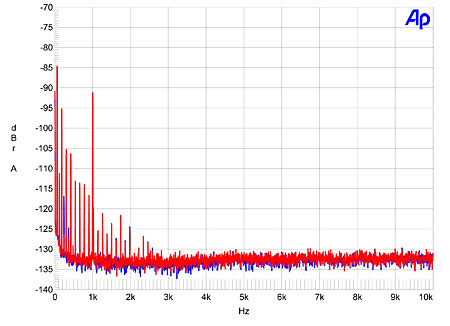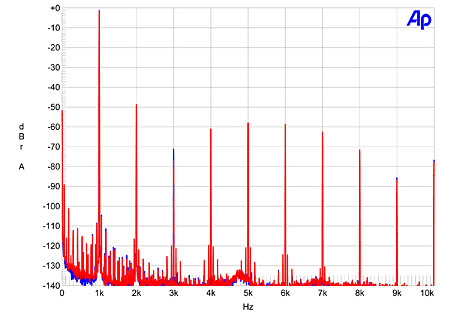| Columns Retired Columns & Blogs |
Wavelength Cosecant v3 USB digital/analog converter Measurements
Sidebar 3: Measurements
To measure the Wavelength Cosecant's performance, I used the Audio Precision SYS2722 system (see www.ap.com and "As We See It" in the January 2008 issue), as well as our Audio Precision System One. The source was my G4 Mac mini running OS10.4.11, with the test-signal WAV files played with iTunes and Bias Peak Pro 6.0. For some tests, I also used a Dual-Core Pentium PC running Windows XP SP3, using Audacity to play the files, and at the very end of this issue's production cycle, I repeated some measurements using an Intel MacBook as the source and Audio Precision's v.3.30 software update.
The Cosecant identified itself to the host computers as "Cosecant USBDAC" from "Wavelength Audio, Ltd.," and the serial number string was "Numerator," confirming that the review sample was fitted with the Numerator DAC, which uses a high-performance Wolfson DAC chip. A USB Prober utility confirmed that the Wavelength could handle 24-bit data and sample rates up to 96kHz, that it uses a Texas Instruments chip, and that it operated in "Isochronous asynchronous" mode. I performed all the tests first with the Cosecant set to unbalanced output, which grounds the negative side of the output-transformer secondaries. I then repeated the tests with the Cosecant in balanced mode, which leaves the secondaries floating with respect to ground. Where the results are different, I mention this in the text.
The Cosecant's maximum output was 3.65V, 5.3dB higher than the CD standard's 2V RMS, and it inverted polarity. The output impedance was a respectably low 345 ohms at low and middle frequencies, dropping further to 305 ohms at 20kHz. The frequency response had a slight downward tilt below 300Hz, reaching –1dB at 13Hz (fig.1, top pair of traces). This wasn't affected by dropping the load impedance to the demanding 600 ohms (fig.12, bottom traces), or by changing to balanced operation. At the other end of the spectrum, there was a slightly premature rolloff with CD data (fig.1, middle traces), reaching –1dB at 17.5kHz; again, this wasn't affected by the loading or balanced operation. With 96kHz data, the gentle rolloff continued, reaching –3dB at 38kHz (fig.1, top traces). Channel separation (not shown) was identical in both unbalanced and balanced modes; it was excellent in the low treble, at 100dB in both directions, and was still better than 86dB at 20kHz, but worsened with decreasing frequency to 52dB at 20Hz, presumably due to coupling between the output transformers.

Fig.1 Wavelength Cosecant v3, unbalanced output, frequency response at –12dBFS into 100k ohms (top) and 600 ohms (bottom) with 44.1kHz and 96kHz-sampled data (right channel dashed, 1dB/vertical div.).
For historical continuity with my reviews of digital products, my primary test for resolution is to sweep a 1/3-octave bandpass filter from 20kHz to 20Hz while the device under test decodes dithered data representing a 1kHz tone at –90dBFS. Fig.2 shows the resulting spectra with the Cosecant fed 16- and 24-bit data (top and bottom pairs of traces, respectively). The peak representing the 1kHz tone peaks at exactly –90dBFS, implying minimal linearity error; the lower-frequency peaks lie at 60Hz and its harmonics and are primarily due, I suspect, to inductive coupling between the output and power-supply transformers (see later). This graph was taken with the Cosecant set to its balanced output mode; switching to unbalanced slightly increased the levels of the power-supply–related spuriae (though the second harmonic at 120Hz disappeared) but, more important, lowered the level of the noise floor at higher frequencies to imply resolution of at least 18 bits. Figs. 3 and 4 show FFT-derived spectra taken from the balanced output with 16- and 24-bit data, respectively. Again, the hum harmonics can be seen, and the upper-frequency noise floor doesn't drop by as much as it did with unbalanced operation. I did try reversing the polarity of the AC supply's AC plug; that increased the level of the hum, so I stuck with the original polarity.

Fig.2 Wavelength Cosecant v3, balanced output, 1/3-octave spectrum with noise and spuriae of dithered 1kHz tone at –90dBFS with 16-bit data (top) and 24-bit data (bottom). (Right channel dashed.)

Fig.3 Wavelength Cosecant v3, balanced output, FFT-derived spectrum with noise and spuriae of dithered 1kHz tone at –90dBFS with 16-bit data (left channel blue, right red).

Fig.4 Wavelength Cosecant v3, balanced output, FFT-derived spectrum with noise and spuriae of dithered 1kHz tone at –90dBFS with 24-bit data (left channel blue, right red).
It is important not to make too much of the presence of hum in the Cosecant's output. Even the highest-level component of this hum, at 60Hz, lies more 90dB down from peak level, which will be inaudible—except, perhaps, through horn-loaded loudspeakers. But to investigate the conditions under which the hum arose, I took two FFT-derived spectra with the Cosecant decoding 24-bit data representing "digital black." Fig.5 was taken in the worst-case situation, with the Cosecant set to unbalanced operation and with the power supply next to it on the test bench. The series of 60Hz odd-order harmonics is clearly evident—odd-order power-supply noise is always due to magnetic induction, I have found—and the 60Hz component lies at –77dBFS (0.014%). Fig.6 was taken in the best-case situation, with the Cosecant in balanced mode and the power supply as far away as the umbilical cable would allow, and oriented to give the lowest coupling to the Cosecant's output transformers. The hum components have dropped by 10dB or more, though some low-level even-order harmonics have appeared, and the noise floor is a couple of dB higher.

Fig.5 Wavelength Cosecant v3, unbalanced output, FFT-derived spectrum with noise and spuriae of 24-bit digital black with power supply adjacent (left channel blue, right red).

Fig.6 Wavelength Cosecant v3, balanced output, FFT-derived spectrum with noise and spuriae of 24-bit digital black with power supply far away (left channel blue, right red).
Linearity error with 16-bit data was minimal to below –100dBFS (not shown), though the waveform of an undithered sinewave at exactly –90.31dBFS was overlaid with a little high-frequency noise (fig.7).

Fig.7 Wavelength Cosecant v3, balanced output, waveform of undithered 1kHz sinewave at –90.31dBFS, 16-bit data (left channel blue, right red).
The Wavelength's single-ended tube output stage is not going to be the most linear of circuits at high levels, so I wasn't surprised to see that, fed a 1kHz tone at 0dBFS, the Cosecant produced a regular series of distortion harmonics (fig.8), with the second harmonic the highest in level at –49dBFS (0.32%). But dropping the signal level by 6dB reduced the level of the second harmonic by 12dB (fig.9), and a 10dB reduction in signal level decreased the level of the second harmonic to –60dB with respect to the fundamental (0.1%), and the higher-order harmonics to levels where they should be inaudible (fig.10). At low frequencies, the distortion was about 10dB worse (not shown), presumably due to the output transformer's core starting to saturate. But again, the distortion rapidly dropped with decreasing signal level.

Fig.8 Wavelength Cosecant v3, balanced output, spectrum of 1kHz sinewave at 0dBFS into 100k ohms, 24-bit data (left channel blue, right red; linear frequency scale).

Fig.9 Wavelength Cosecant v3, balanced output, spectrum of 1kHz sinewave at –6dBFS into 100k ohms, 24-bit data (left channel blue, right red; linear frequency scale).

Fig.10 Wavelength Cosecant v3, balanced output, spectrum of 1kHz sinewave at –10dBFS into 100k ohms, 24-bit data (left channel blue, right red; linear frequency scale).
Because of the tube circuit's poor linearity at maximum level, I ran the high-frequency intermodulation test at a level 6dB below full scale. However, while the higher-order intermodulation products in fig.11 are at or below –60dB (0.1%), the second-order difference component at 1kHz lay at –38dB (1.3%), which is disappointing. With a 0dBFS signal, it rose to –24dB (15%). Ugh!

Fig.11 Wavelength Cosecant v3, unbalanced output, HF intermodulation spectrum, 19+20kHz at –6dBFS peak into 100k ohms, 24-bit data (left channel blue, right red; linear frequency scale).
Finally, at first I didn't measure as good jitter rejection from the Cosecant as I had expected to from the graphs that Wavelength's Gordon Rankin had sent me, and from the fact that it operates in asynchronous USB mode with the DAC controlling the flow of data from the host computer. Using the AC-powered Mac mini as the source of the 16-bit Miller-Dunn J-Test signal, while data-related sidebands were absent from the FFT-derived, high-resolution spectrum of the Cosecant's output, some sidebands were present at AC power-supply–related frequencies and there was some spectral spreading of the central spike that suggested the presence of random low-frequency jitter (fig.12). I retested the Cosecant using the battery-powered MacBook. Again, no data-related sidebands can be seen (fig.13), and now the central spike is well-defined, with just one pair of sidebands visible ±60Hz. This is the best jitter performance I have measured from a DAC fed USB audio data.

Fig.12 Wavelength Cosecant v3, high-resolution jitter spectrum of analog output signal, 11.025kHz at –6dBFS, sampled at 44.1kHz with LSB toggled at 229Hz, 16-bit data, Mac mini source. Center frequency of trace, 11.025kHz; frequency range, ±3.5kHz (left channel blue, right red).

Fig.13 Wavelength Cosecant v3, high-resolution jitter spectrum of analog output signal, 11.025kHz at –6dBFS, sampled at 44.1kHz with LSB toggled at 229Hz, 16-bit data. Intel MacBook source. Center frequency of trace, 11.025kHz; frequency range, ±3.5kHz (left channel blue, right red).
The Wavelength Cosecant is an odd mix of state-of-the-art digital engineering and retro analog audio engineering. As long as the signal level is at –10dBFS or below, which it will be most of the time with classical music or jazz, then the tube's nonlinearity will not be an issue, especially as the prime component of the distortion is the subjectively innocuous second harmonic. But I didn't like the high-frequency intermodulation performance. And owners should take care to site the power supply as far as possible from the audio chassis, as well as experiment with unbalanced or balanced operation to get the lowest level of background noise.—John Atkinson
- Log in or register to post comments




































